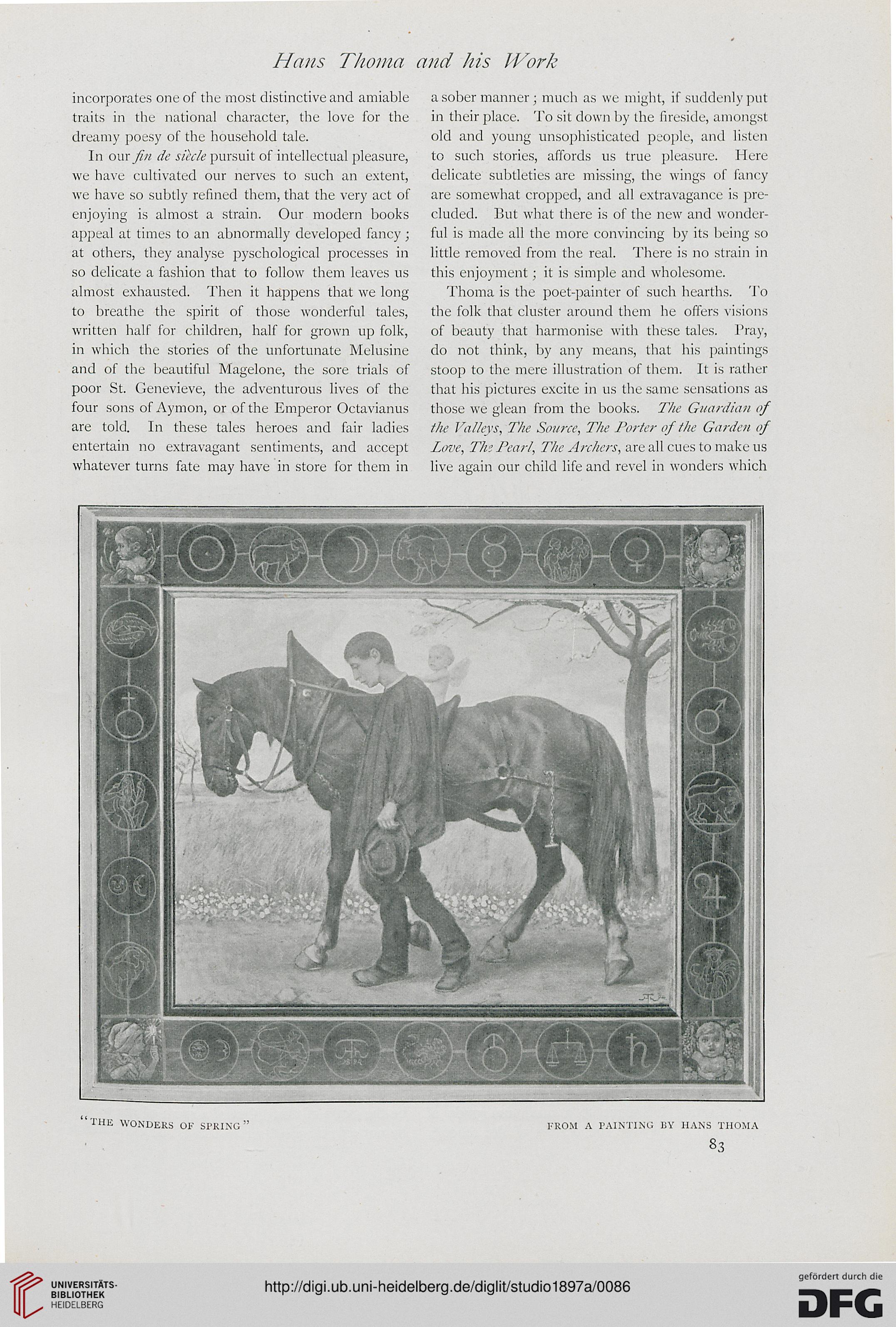Hans Thoma and his Work
incorporates one of the most distinctive and amiable
traits in the national character, the love for the
dreamy poesy of the household tale.
In our fin de siccle pursuit of intellectual pleasure,
we have cultivated our nerves to such an extent,
we have so subtly refined them, that the very act of
enjoying is almost a strain. Our modern books
appeal at times to an abnormally developed fancy ;
at others, they analyse pyschological processes in
so delicate a fashion that to follow them leaves us
almost exhausted. Then it happens that we long
to breathe the spirit of those wonderful tales,
written half for children, half for grown up folk,
in which the stones of the unfortunate Melusine
and of the beautiful Magelone, the sore trials of
poor St. Genevieve, the adventurous lives of the
four sons of Aymon, or of the Emperor Octavianus
are told. In these tales heroes and fair ladies
entertain no extravagant sentiments, and accept
whatever turns fate may have in store for them in
a sober manner ; much as we might, if suddenly put
in their place. To sit down by the fireside, amongst
old and young unsophisticated people, and listen
to such stories, affords us true pleasure. Here
delicate subtleties are missing, the wings of fancy
are somewhat cropped, and all extravagance is pre-
cluded. But what there is of the new and wonder-
ful is made all the more convincing by its being so
little removed from the real. There is no strain in
this enjoyment; it is simple and wholesome.
Thoma is the poet-painter of such hearths. To
the folk that cluster around them he offers visions
of beauty that harmonise with these tales. Pray,
do not think, by any means, that his paintings
stoop to the mere illustration of them. It is rather
that his pictures excite in us the same sensations as
those we glean from the books. The Guardian of
the Valleys, The Source, The Porter of the Garden of
Love, Thi Tear/, The Archers, are all cues to make us
live again our child life and revel in wonders which
incorporates one of the most distinctive and amiable
traits in the national character, the love for the
dreamy poesy of the household tale.
In our fin de siccle pursuit of intellectual pleasure,
we have cultivated our nerves to such an extent,
we have so subtly refined them, that the very act of
enjoying is almost a strain. Our modern books
appeal at times to an abnormally developed fancy ;
at others, they analyse pyschological processes in
so delicate a fashion that to follow them leaves us
almost exhausted. Then it happens that we long
to breathe the spirit of those wonderful tales,
written half for children, half for grown up folk,
in which the stones of the unfortunate Melusine
and of the beautiful Magelone, the sore trials of
poor St. Genevieve, the adventurous lives of the
four sons of Aymon, or of the Emperor Octavianus
are told. In these tales heroes and fair ladies
entertain no extravagant sentiments, and accept
whatever turns fate may have in store for them in
a sober manner ; much as we might, if suddenly put
in their place. To sit down by the fireside, amongst
old and young unsophisticated people, and listen
to such stories, affords us true pleasure. Here
delicate subtleties are missing, the wings of fancy
are somewhat cropped, and all extravagance is pre-
cluded. But what there is of the new and wonder-
ful is made all the more convincing by its being so
little removed from the real. There is no strain in
this enjoyment; it is simple and wholesome.
Thoma is the poet-painter of such hearths. To
the folk that cluster around them he offers visions
of beauty that harmonise with these tales. Pray,
do not think, by any means, that his paintings
stoop to the mere illustration of them. It is rather
that his pictures excite in us the same sensations as
those we glean from the books. The Guardian of
the Valleys, The Source, The Porter of the Garden of
Love, Thi Tear/, The Archers, are all cues to make us
live again our child life and revel in wonders which




